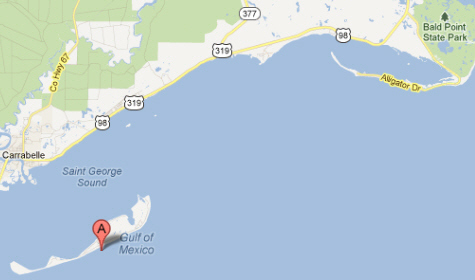Malcolm R. Campbell's Blog, page 211
September 14, 2014
Review: ‘Summer of the Long Knives’ by L. S. Bassen
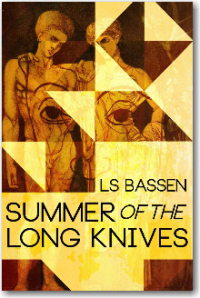 L. S. Bassen, a 2011 Flannery O’Connor Award finalist, has written a strong alternative history novel with her Signal 8 Press (July 22, 2014) release of Summer of the Long Knives. “Night of the Long Knives” is an old German phrase used to describe acts of revenge, most famously German Chancellor Adolf Hitler’s murderous purge of his political opponents in the summer of 1934.
L. S. Bassen, a 2011 Flannery O’Connor Award finalist, has written a strong alternative history novel with her Signal 8 Press (July 22, 2014) release of Summer of the Long Knives. “Night of the Long Knives” is an old German phrase used to describe acts of revenge, most famously German Chancellor Adolf Hitler’s murderous purge of his political opponents in the summer of 1934.
The novel begins its “alternity” approach with the first sentence: “Very little from a personal perspective has been written about the assassination of German Chancellor Adolf Hitler on July 1, 1934, following the so-called Night of the Long Knives.” Summer of the Long Knives is a haunting story about who killed an imaginary Adolph Hitler in his Chancellery gardens and why.
The fictional Dr. Anne Frank-Koestler is quoted in this mix of well-researched history and intuitive “what ifs?” as saying that as the journalist concerns himself with facts, the historian is an artist who concerns himself with the art of creating pictures of meaningful events and periods of human affairs that while not factually accurate, might just be a “truer” version than the account of the past that we know.
This “truer” account in Bassen’s story isn’t a denial of German history, but an exploration of the real summer of 1934 by merging it with “what if?” in the same spirit that authors create alternative ends to America’s critical Civil War battles and ask readers to imagine the resulting version of history. Bassen provides a backdrop so real that her characters’ lives–phantoms though they may be–seem equally real. Artist Albert Entrater, model Lisel Gantz and Catholic priest Konrad Hoeffer are involved in an assassination plot that the reader hopes will succeed as though the world might in fact change by the end of the novel.

The real is clarified by the imaginary in Bassen’s novel.
Imagined headlines bring us the news: HITLER KILLED A DAY AFTER CRUSHING NAZI RADICAL REVOLT: RÖHM A SUICIDE: VON PAPEN, VON BLOMBERG RESTORE ORDER
The imaginary Albert Entrater survives. Anne Frank survives. Hitler does not. Those who believe in the furthest reaches of quantum theory tell us that whatever can happen does happen–somewhere, in another universe perhaps, or at the very least, in our minds after we read alternative histories.
The world we know is the world we know, but in another universe, Abraham Lincoln wasn’t assassinated at Ford Theater and Adolph Hitler was assassinated via one plot or another. And just maybe a young girl named Lisel Gantz, who was assaulted by brownshirt Stormtroopers and subsequently sought her revenge, pulled the trigger.
In the “what if?” world of an alternative history, The Summer of the Long Knives is at once a fictional thriller and a chilling exploration of the German summer of 1934.


September 12, 2014
Book club extras for ‘Emily’s Stories’
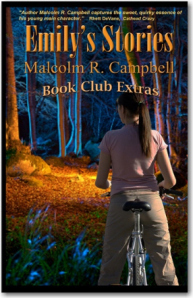
Free
Emily’s Stories is a three-story set about a teenager who solves problems with a combination of logic and intuition, and that includes talking to birds and ghosts. The book, from Vanilla Heart Publishing, is available in paperback, as an e-book in multiple formats and as an audio book.
The book is an excellent selection for library programs and book clubs that focus on family reading. If your club is considering Emily’s Stories, you can download the free “book club extras” PDF for more information about the book. The PDF includes starter questions for both teen-oriented and adult-oriented clubs.
Click on the graphic for your free download, and then enjoy reading and talking about Emily’s Stories.
Two of the stories are set in the Florida Panhandle; the other is set at Iceberg Lake in Glacier National Park. You can learn more about the book at its Amazon page.
You have three more days to stop by GoodReads and enter the give-away for a chance to win a free paperback copy of my contemporary fantasy novel “The Sun Singer.”


September 11, 2014
Briefly Noted: ‘Gatherings: Friends and Recipes from Montana’s Mustang Kitchen’
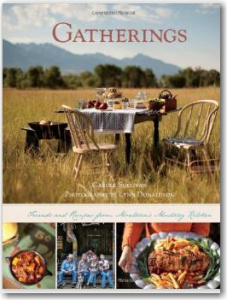 Special guests at Mustang Cafe and Catering in Livingston, Montana include Oprah Winfrey, Diane Sawyer, John Turturro, Anthony Bourdain, Tom Brokaw, Ivon Chaniard, Sandra Day O’Connor, Walter Kirn, Tom McGuane, Jim Harrison, Margot Kidder, Carl Haissan, and John Heard. When folks who can afford to eat anywhere in the world stop by for a meal, that’s a good sign.
Special guests at Mustang Cafe and Catering in Livingston, Montana include Oprah Winfrey, Diane Sawyer, John Turturro, Anthony Bourdain, Tom Brokaw, Ivon Chaniard, Sandra Day O’Connor, Walter Kirn, Tom McGuane, Jim Harrison, Margot Kidder, Carl Haissan, and John Heard. When folks who can afford to eat anywhere in the world stop by for a meal, that’s a good sign.
And, it suggests that a recipe book based on the best from Mustang’s kitchen, might just bring that great food to your home.
From the Publisher: Featuring more than 100 original recipes from Mustang Fresh Food and Catering, Gatherings: Friends and Recipes from Montana’s Mustang Kitchen brings the magic of Chef Carole Sullivan’s personalized and authentic catering to your home kitchen. From Livingston, Montana Carole Sullivan has prepared meals for tough customers such as Martha Stewart and President Barack Obama. Each chapter is organized into custom menus that Sullivan has served to her loyal clientele, and accompanied by mouthwatering photographs by photographer Lynn Donaldson. Together the team brings us menus designed for every occasion, from streamside picnics to formal holiday dinners, with all the recipes adapted for simple and savory home cooking. Try Jeff and Susan Bridges’ Thanksgiving feast or sample Michael Keaton’s annual July 4th barbecue. This is real food for real people.
-
Book Signing: Carol Sullivan will be signing books at Costco in Bozeman this Saturday, September 13, 2914) from 12-2 pm.


September 7, 2014
Day of Rest
“Every person needs to take one day away. A day in which one consciously separates the past from the future. Jobs, family, employers, and friends can exist one day without any one of us, and if our egos permit us to confess, they could exist eternally in our absence. Each person deserves a day away in which no problems are confronted, no solutions searched for. Each of us needs to withdraw from the cares which will not withdraw from us.” – Maya Angelou (Wouldn’t Take Nothing for My Journey Now)
 When I saw this quotation on Terri Windling’s Myth and Moor blog, I started thinking that while a writer’s life must appear serene to those who work in more active jobs, it’s very hard to allow oneself to get that day of rest.
When I saw this quotation on Terri Windling’s Myth and Moor blog, I started thinking that while a writer’s life must appear serene to those who work in more active jobs, it’s very hard to allow oneself to get that day of rest.
If one is actively writing a story, the characters seldom take a day off. They’re always jabbering away inside the writer’s head. Or, s/he is thinking of facts to check or scenes that require another look. If one is not actively writing a story, then it’s easy to feel the need to be posting something on a blog like this one or on a Facebook page.
Case in point: before I saw that quote about taking a day off, I was thinking of writing a post in response to a writer/reviewer who doesn’t think Rowling’s adult books are all that good. I don’t agree and was going to say why–not that it matters one way or another in the scheme of things what I think about Rowling’s books.
But in thinking about a day of rest–after I’ve already gone to the store and cleaned out the gutters over the front door—going through that reviewer’s negative Rowling points one by one, seemed very in-restful. So, I’m letting that go in favor of reading more of her latest “Robert Galbraith” detective story The Silkworm.
Growing up, I never looked forward to Sunday because–in that era and in that town–Sunday afternoons were reserved for calling on other people. My two brothers and I were ordered to stay in our Sunday clothes, keep our rooms clean, and not to get involved in any games that messed up the house. It was not a day of rest.
Traditionally, I think of Sunday as a day of rest even though a fair number of people are working at the restaurants, movie theaters, malls and other places where many people go to rest. Folks are still working their yards, though possibly not starting up their lawn mowers quite as early as they do on Saturday.
There’s always football and beer, and whether one slumps on the couch with a six pack or has friends over for grilling, that’s probably better than heading off to the office to catch up on paperwork or clearing the thicket of privet out of the backyard. There’s always taking a nap. For some, there are hobbies that provide some of the best relaxation on the planet. Perhaps one can also call it rest.
We need more than we’re getting even if we have to trick ourselves into resting rather than thinking of all the stuff we ought to be doing. Thank goodness, the era of people dropping by to call on Sunday afternoons is long gone. For a kid or a writer, boring conversation is hell rather than rest.
Now, time to pick up my copy of The Silkworm in spite of what that reviewer said about it, and get some well-deserved rest after yesterday afternoon’s yard work. Later this afternoon, there’s a U. S. Open Tennis game I want to watch, er, with a glass of wine rather than a six pack of anything
–Malcolm
P.S. Thank you, Mel Mathews for your kind words about The Sun Singer in ‘The Sun Singer’ – The Hero’s Journey par Excellence


September 4, 2014
Review: ‘Parallax Groove’ by Michael Loughrey
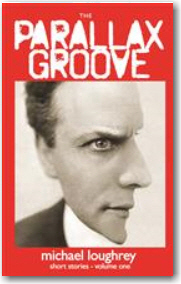 Gentle readers are urged to approach Parallax Groove with caution, beginning with the fact the book’s back cover copy proclaims that these fabulist stories comprise “fiction free from the straightjacket of realism.” Readers of nature poetry, beach fiction and sweet bedtime romances will discover that a little bit of this book goes a long way (perhaps too far).
Gentle readers are urged to approach Parallax Groove with caution, beginning with the fact the book’s back cover copy proclaims that these fabulist stories comprise “fiction free from the straightjacket of realism.” Readers of nature poetry, beach fiction and sweet bedtime romances will discover that a little bit of this book goes a long way (perhaps too far).
Literary aficionados attracted to dangerous, and perhaps life threatening, adventure reading will find everything (and perhaps more) that they can possibly want within the realm of dazzling wordplay, clever references, and unrestrained, profane (and possibly grotesque) incidents and imagery taunting them on the pages blisteringly occupied with Loughrey’s fourteen stories.
If you cannot laugh (and perhaps marvel) at the characters and plots from the positively purple “Illustration No. 8″ to the blacker than black “Omega, maybe,” then you will weep for the state of a world that can be so accurately, word-in-cheek satirized by such stores. (The word “such” is not meant to imply there are any other stories on the planet remotely like those in Parallax Groove.)
Perhaps we’re doomed and this collection is our last hurrah. The opening words of “Omega, maybe” begin a cautionary tale: “And it came to pass that The End came and went. the unwavering cycle of hours, minutes and seconds of the final countdown as monotonous, neutral and unstoppable as they had always been whilst calibrating Man’s plodding passage through times good or bad.”
En route to “Omega, maybe,” we experience “Original sin,” “Still life with bacteria” and “Reclining nude with machete.” Readers addicted to the high of well executed fictional extremes should jump into the wild surf of Loughrey’s nightmares and/or enchantments and let the undertow of his words carry them wherever they will.
You’ll drown if you fight it. Otherwise, what a ride!
Malcolm R. Campbell is the author of contemporary fantasy novels, including “The Seeker,” “The Sailor” and “The Betrayed.”


September 2, 2014
Synchronicity and our Stories

Walk into the woods with an open mind. You’ll be surprised at what you find there and how much it meets the needs of the stories you’re telling.
We often notice how many things come in threes and how often seeing and noticing a thing (car make, idea, book) leads us to seeing it again soon.
I’ve often thought that where we focus our attention seems to enhance whatever it is we’re looking at and thinking about. So it is that whenever we begin to casually think about a story idea, we find ourselves stumbling over the ideas for scenes that will enhance the plot and characters that will be memorable after readers get to the last line.
Passion seems to fuel an interesting synchronicity throughout the research as well. One thing leads to another thing which leads to marvels that truly fit the story that we weren’t even looking for. The Internet and its links plays into this unfolding scavenger hunt for relevant facts, prospective locations, and the little details that can make or break a story.
Recently, a writer friend of mine told me about a call for submissions from an upcoming anthology of ghost stories about a city many miles away from there I live. The publisher wanted new paranormal stories that fit the city and its attractions and culture or new takes on legends and haunted places.
My first thought was to dismiss the idea out of hand. There was no way could fly or drive to that city and soak up its ambiance and turn my impressions into a story. But, if you’ll pardon the pun, the idea haunted me. An Internet search turned up a few ghostly legends that might possibly be brought forward into a current-day story. One legend kept drawing me into the facts and suppositions people had about it at the time it happened over a hundred years ago.
I kept saying I was just dabbling with the idea because, really, the anthology seemed best suited to people who lived in the city and who knew it well. Okay, maybe I could use Google’s maps and street view to see what the place looked like. Hmm, spooky. Then I stumbled across an author who’d written a book about the incident and who had been inside the house where it happened.
Oops, I just got hooked into submitting something. I have no idea whether the publisher will like it.* Either way, I had a good time watching characters, real-life facts, ghostly musings and plot ideas unfold before my eyes as though they had a mind of their own. Did the ghost herself lead me into her lair? Naah, stuff like that doesn’t happen. But the synchronicity behind the things an author becomes interested in is typical.
Another author recently said that whenever we choose to involve ourselves in a story, the universe aligns itself with us to help us tell the tale. I like that idea, and I find it works best if I don’t begin my dabbling with either an outline or a preliminary list of prospective characters.
These approaches may or may not be helpful later, but if they’re used too soon, they tend to restrict the incoming flow of information. How? Because the outline tends to limit the synchronicity to that which you include in the outline, leaving out the better ideas a writer could have used if s/he hadn’t made arbitrary decisions before the universe showed him what was possible.
I love discovering stories while I’m writing them.
-
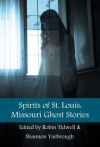 Update: That story, “Patience, I Presume,” was accepted for publication in the Rocking Horse Publishing anthology Spirits of St. Louis: Missouri Ghost Stories.
Update: That story, “Patience, I Presume,” was accepted for publication in the Rocking Horse Publishing anthology Spirits of St. Louis: Missouri Ghost Stories.
This post, written last summer, is from the Magic Moments blog archive. Before I removed that blog from WordPress, I wanted to share a few of the entries.


August 31, 2014
If I were J. D. Salinger, I could sell all this stuff for millions
“Actually, this is just a place for my stuff, ya know? That’s all; a little place for my stuff. That’s all I want, that’s all you need in life, is a little place for your stuff, ya know? I can see it on your table, everybody’s got a little place for their stuff. This is my stuff, that’s your stuff, that’ll be his stuff over there.” – George Karlin, A Place for My Stuff Lyrics
 Writers tend to save paper stuff – books, magazines, newspapers, clippings, letters, certificates, notes, business cards, programs, photographs, greeting cards, postcards, legal papers, vintage business forms, brochures and guidebooks, old highway maps, maps of the world the way it was when they were born, grade school drawings and fake Confederate money from old Cheerios boxes.
Writers tend to save paper stuff – books, magazines, newspapers, clippings, letters, certificates, notes, business cards, programs, photographs, greeting cards, postcards, legal papers, vintage business forms, brochures and guidebooks, old highway maps, maps of the world the way it was when they were born, grade school drawings and fake Confederate money from old Cheerios boxes.
I even saved my deed for an inch of land in the Klondike from out of a Quaker Oats box long after the Big Inch Land Company went out of business. I had big plans for that square inch.
There’s an unwritten rule about paper stuff: once you throw it away, you’ll need it.
I’ve thrown away a lot of stuff and then regretted in some years later when I needed it for a book or article I was writing.
Brainwashing, Bad Genes, Or Bad Karma
The Karma train is at least 100 cars long.
I probably threw out somebody’s stuff in a previous life and now the karma train has dropped it off at my house in this life. Otherwise, all this stuff is my parents’ fault. Here’s why: brainwashing. Before I could walk or talk, I knew that stuff was the be-all and end-all of a writer’s life no matter how many rooms of the house it took up, and even if you didn’t know what it was and never looked at it.
When my wife, brothers and their wives and I cleaned out my parents’ house in the 1980s, the place was filled with paper stuff. If they had been famous people, this would have been the kind of stuff that ended up in the basement of a historical society where online references would refer to it as X number of linear feet of unsorted papers: please contact the archivist for an appointment. Hourly research fees to find what may or may not be in one of the boxes are $150.
I threw away a lot of the stuff. We got rid of a lot of the larger stuff in a garage sale and got roundly criticized by my parents’ friends got getting rid of the stuff. We explained that we lived in small apartments and houses and had no room for a giant household full of stuff that wouldn’t even fit in a moving van.
Time being short to get out of that house, we moved some of the stuff with us. My wife and I have moved several times since then, usually bringing along the boxes, still labelled as they were in the mid-1980s without looking in them.
Time to See What The Hell All this Stuff Is
Well, now I have to look into them. We no longer have room for it. So, I’ve been throwing away stuff for the past several months. I hated to see some of it go because, well, it must have been important stuff at one time or another, the kind of stuff I could sell for millions if I had the fame of Salinger or Rowling.
They have room for some of my book-type stuff
I have a tip for you: if you save paperwork from several generations back in time, eBay doesn’t want it. I’ve dumped (donated) 15 boxes of books to the local library for their yearly garage sale and I think I’ve just about worn out my welcome. The recycling center knows my name because they’ve seen me dump some 50-60 grocery bags of magazines and “office paper” into the recycling bins.
Throwing away stuff would be easy if I could tent a backhoe and a dumpster and clear the “treasures” out of the house during a long afternoon. Even though my parents never hid $100 bills in old books and papers, I keep thinking, “But the time I don’t check, that’s when it will be there.”
But then I would never know, so it would be the same as it not being there.
I should have listened more closely to George Karlin’s “A Place for My Stuff” the first time I heard it. I guess I thought it only applied to non-writers.
So far, nobody’s called and said, “Malcolm, you know that crap you threw out two months ago? I was going to give you $100000000000 for it, but you weren’t answering your phone that week.”
For years, I thought, I’ll wait one more week to see if I need this stuff or somebody calls and wants to buy it. You see how it goes and why there’s so much of it.
-
You may also like: You Should Spend Money on Experiences, Not Things: Anticipation of a new experience is the best part, new data shows - “It’s been over a decade since American psychologists Leaf Van Boven and Thomas Gilovich concluded that doing things makes people happier than having things.”
 Malcolm R. Campbell is the author of contemporary fantasy adventure novels including “The Sailor” and “The Sun Singer.”
Malcolm R. Campbell is the author of contemporary fantasy adventure novels including “The Sailor” and “The Sun Singer.”


August 30, 2014
GoodReads giveaway for ‘The Sun Singer’
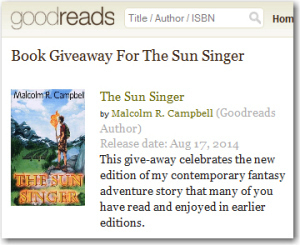 The paperback edition of my contemporary fantasy novel The Sun Singer was released by Second Wind Publishing under its Blue Shift imprint on August 17.
The paperback edition of my contemporary fantasy novel The Sun Singer was released by Second Wind Publishing under its Blue Shift imprint on August 17.
Now you have a chance to win a free copy of an uncorrected ARC by entering the GoodReads give-away by September 15, 2014. Five free copies are available to residents within the United States.
Click on the graphic and you’re read to enter.


August 28, 2014
On Location: Glacier National Park
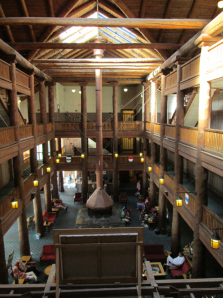
Lobby of Many Glacier Hotel, built in 1915.
Those who have followed this blog for years know that I worked as a hotel bellman at Glacier National Park’s Many Glacier Hotel while in college and that I’ve returned to the park when finances permit.
I suppose many people have a favorite beach, romantic city, mountain range or scenic highway they call my favorite place, and that for reasons they may not be able to explain, are drawn to it time and again.
Glacier is my favorite place, though it hasn’t been easy falling in love with it inasmuch as I live in the Southeast and travel to and from the park in northwestern Montana takes time and/or money. The historic hotels, many of which were constructed by the Great Northern Railway many years ago, are only open between June and September. This means the primary park season is short and room rates are high.
Most people reach the park by car via U. S. Highway 2 or by air via Kalispell which is near the west entrance to the park. Some people fly in via Calgary, Alberta and then visit Jasper, Banff, and Waterton parks in Alberta before driving south past Chief Mountain into Montana to tour Glacier. Glacier is named for its glacier-carved mountains with a geography featuring horn-shaped peaks, narrow aretes, cirque lakes and stair-step valleys. Existing glaciers add glacial flour (finely ground rock) to the water and that makes for turquoise colored lakes.
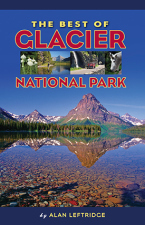 Due to an ancient thrust-fault, there are places where you’ll see older rock on top of younger rock. Many rock strata are visible throughout the park. If you take a launch trip on Swiftcurrent Lake, Lake Josephine, St. Mary Lake, Lake McDonald or Two Medicine lake, the guides will point out the rock strata along with glaciers (slowly melting away), waterfalls (a lot, especially early in the summer), primary peaks, wildlife (including grizzly bears), and other points of interest.
Due to an ancient thrust-fault, there are places where you’ll see older rock on top of younger rock. Many rock strata are visible throughout the park. If you take a launch trip on Swiftcurrent Lake, Lake Josephine, St. Mary Lake, Lake McDonald or Two Medicine lake, the guides will point out the rock strata along with glaciers (slowly melting away), waterfalls (a lot, especially early in the summer), primary peaks, wildlife (including grizzly bears), and other points of interest.
If you like hiking, there are 700 miles of trails for you to choose from. My favorite is the Highline Trail which you can use to go from Logan pass on Sun Road to Granite Park Chalet to Many Glacier Hotel on the east side. Many trails remain closed due to snow throughout June, so check with the park service about trail closures if you go early in the summer.
If you have time, take a red bus trip on Sun Road or up to Waterton. These 1936 restored tour buses are fun to ride in and, when the convertible tops are rolled back, give you a great view of the mountains. If your time in the park is short, consider including one bus tour, a launch trip, and scheduling in some time for short hikes around the hotel where you’re staying. Alan Leftridge’s book (shown here) lists the best places to see, grouped by category. It’s a valuable guide for people who only have a day or so for a quick trip.
 If you have problems with stairs, you should know that while Many Glacier Hotel has an elevator in the main section, the four floors of rooms in the annex are accessible only by steep stairs. Glacier Park Lodge has no elevators, so try to get a room at ground level. I found the foods served in the main dining rooms of the hotels to be tasty, but overly rich. (Be sure to try at least one of the deserts, drinks or ice creams made with Huckleberries.) If you’re there for a few days, you can venture out to Swiftcurrent if you’re staying at Many Glacier, multiple private restaurants at East Glacier if you’re staying at Glacier Park Lodge, several restaurants at St. Mary if you’re staying at Rising Sun, and a variety of restaurants at Apgar and Kalispell if you’re staying at McDonald Lodge. Bison Creek Ranch a few miles for East Glacier is a favorite of mine for steaks and chicken.
If you have problems with stairs, you should know that while Many Glacier Hotel has an elevator in the main section, the four floors of rooms in the annex are accessible only by steep stairs. Glacier Park Lodge has no elevators, so try to get a room at ground level. I found the foods served in the main dining rooms of the hotels to be tasty, but overly rich. (Be sure to try at least one of the deserts, drinks or ice creams made with Huckleberries.) If you’re there for a few days, you can venture out to Swiftcurrent if you’re staying at Many Glacier, multiple private restaurants at East Glacier if you’re staying at Glacier Park Lodge, several restaurants at St. Mary if you’re staying at Rising Sun, and a variety of restaurants at Apgar and Kalispell if you’re staying at McDonald Lodge. Bison Creek Ranch a few miles for East Glacier is a favorite of mine for steaks and chicken.
If you’re a light sleeper, take a white noise machine. The walls of these old hotels are thin and the doorways are not tight fitting–you won’t want to hear people talking or snoring in adjoining rooms. WiFi in the hotels is only available in a few areas and is overloaded by multiple guests trying to log on. Cell phone reception is spotty or not available. Take multiple layers of clothes. You may need a jacket at night in August and the wind in the higher elevations can be chilly all through the summer. If you have a small umbrella or a fold-up poncho, take it: rain comes out of nowhere.
Yes, the 2014 season only has about a half a month left to go. Had you been at the park a few days ago, you would have seen a great display of the northern lights. The wind at Logan Pass and elsewhere will be getting noticeably colder. You may see some snow in the higher elevations. If you like to ski or hike with snow shoes, the park is open throughout the Winter.
Glacier is on my mind this month with the release of the new paperback* edition my contemporary fantasy adventure novel which is set in and around Many Glacier Hotel. The reality comes from faithfully including what I remember about the Swiftcurrent Valley, Lake Josephine and the Ptarmigan Tunnel. The fantasy comes from a look-alike universe reached via a portal (which you won’t see from the Lake Josephine Launch) hidden near a shelter lean-to used by hikers. If they only knew how close they were to a very dangerous world–as my young protagonist discovers. He’ll have to learn how to use magic if he wants to make it back to the world of Glacier National Park.
* Please be patient if you prefer to read e-books. While posted on bookseller sites, there are formatting issues yet to be resolved.


August 26, 2014
Sky, from the toes up
“I thank you God for this most amazing day, for the leaping greenly spirits of trees, and for the blue dream of sky and for everything which is natural, which is infinite, which is yes.” – e. e. cummings
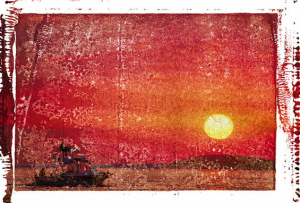 When I was in the first or second grade and learned that the earth revolves, I wondered why the ground did not move beneath my feet when I jumped. How perplexing; I come down just where I started, I thought.
When I was in the first or second grade and learned that the earth revolves, I wondered why the ground did not move beneath my feet when I jumped. How perplexing; I come down just where I started, I thought.
My dad explained that the atmosphere moves with the earth and, in fact, if it didn’t, there would be a substantial windstorm blowing us down around the clock.
For years, I viewed the sky as something far way, especially on clear nights when the stars—according to my observations—moved on flight paths much more distant that clouds, airplanes, or the helium balloons that escaped our grasp at the county fair.
I supposed at an early age that an ant’s view of the sky includes everything from my toes up. My feet are shadows and my hands are clouds and my head is a far planet. I believed they were misinformed and/or had poor eyesight because the sky was miles away.
Dog Island (marked with an “A”) is three and a half miles off the coast.
Early on a Saturday morning when I was in high school, I went to Alligator Bay on the Gulf Coast south of Tallahassee, Florida, with Tommy and Jonathan for a boat ride over to Dog Island. Jonathan’s family had a speed boat anchored just off the beach near his family’s summer cottage. The faraway sky was blue and cloudless, and the water was tranquil.
After a day of swimming, snorkeling and sand-dune exploring, we headed back just as a storm began developing farther to the west. The sky grew very dark before we reached the bay sheltered by Alligator Point. The high chop of the waves slowed our progress, so the afternoon was winding down before we set the anchor and waded ashore. We were quite relieved we hadn’t swamped the boat, something we hadn’t done for a year or two.
As we stood watching the storm pass by outside the bay, the setting sun appeared low on the western horizon with one of the most spectacular golden sunsets I have ever seen. The beach, the boat, and the surf were bright orange and glowing with light. Meanwhile, the lightning from the passing storm to the south of us, was also bright orange, and it hissed as it snaked across the sky over our heads and shook the world with its hollow thunder.
We stood without saying a word, and to this day, I think those moments still represent one of the most mystical experiences I have ever had. On that golden beach just out of the storm’s reach, everything was possible and yes and hopeful and connected. “The sky is everywhere, it begins at your feet,” wrote Jandy Nelson in her young adult novel. Yes it is, and on that afternoon, it was clear to me that I stood within the sky and not below it.
–Malcolm
This post originally appeared on my Magic Moments weblog. As I get ready to shut down that blog, I thought I’d run a few of my favorite posts from the archive. Looking back on that day on the beach made it easier for me to understand a quote from “Seth” in the books by Jane Roberts: “There is no place where consciousness stops and the environment begins, or vice versa.”





